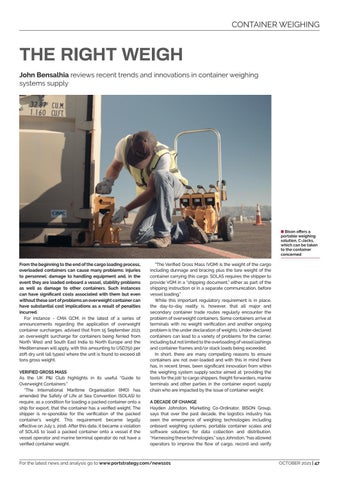CONTAINER WEIGHING
THE RIGHT WEIGH John Bensalhia reviews recent trends and innovations in container weighing systems supply
8 Bison offers a portable weighing solution, C-Jacks, which can be taken to the container concerned
From the beginning to the end of the cargo loading process, overloaded containers can cause many problems: injuries to personnel; damage to handling equipment and, in the event they are loaded onboard a vessel, stability problems as well as damage to other containers. Such instances can have significant costs associated with them but even without these sort of problems an overweight container can have substantial cost implications as a result of penalties incurred. For instance - CMA GCM, in the latest of a series of announcements regarding the application of overweight container surcharges, advised that from 15 September 2021 an overweight surcharge for containers being ferried from North West and South East India to North Europe and the Mediterranean will apply, with this amounting to USD750 per 20ft dry unit (all types) where the unit is found to exceed 18 tons gross weight. VERIFIED GROSS MASS As the UK P&I Club highlights in its useful “Guide to Overweight Containers:” “The International Maritime Organisation (IMO) has amended the Safety of Life at Sea Convention (SOLAS) to require, as a condition for loading a packed container onto a ship for export, that the container has a verified weight. The shipper is re-sponsible for the verification of the packed container’s weight. This requirement became legally effective on July 1, 2016. After this date, it became a violation of SOLAS to load a packed container onto a vessel if the vessel operator and marine terminal operator do not have a verified container weight.
“The Verified Gross Mass (VGM) is the weight of the cargo including dunnage and bracing plus the tare weight of the container carrying this cargo. SOLAS requires the shipper to provide VGM in a “shipping document,” either as part of the shipping instruction or in a separate communication, before vessel loading.” While this important regulatory requirement is in place, the day-to-day reality is, however, that all major and secondary container trade routes regularly encounter the problem of overweight containers. Some containers arrive at terminals with no weight verification and another ongoing problem is the under declaration of weights. Under-declared containers can lead to a variety of problems for the carrier, including but not limited to the overloading of vessel lashings and container frames and/or stack loads being exceeded. In short, there are many compelling reasons to ensure containers are not over-loaded and with this in mind there has, in recent times, been significant innovation from within the weighing system supply sector aimed at ‘providing the tools for the job’ to cargo shippers, freight forwarders, marine terminals and other parties in the container export supply chain who are impacted by the issue of container weight. A DECADE OF CHANGE Hayden Johnston, Marketing Co-Ordinator, BISON Group, says that over the past decade, the logistics industry has seen the emergence of weighing technologies including onboard weighing systems, portable container scales and software solutions for data collection and distribution. “Harnessing these technologies,” says Johnston, “has allowed operators to improve the flow of cargo, record and verify
For the latest news and analysis go to www.portstrategy.com/news101
OCTOBER 2021 | 47











